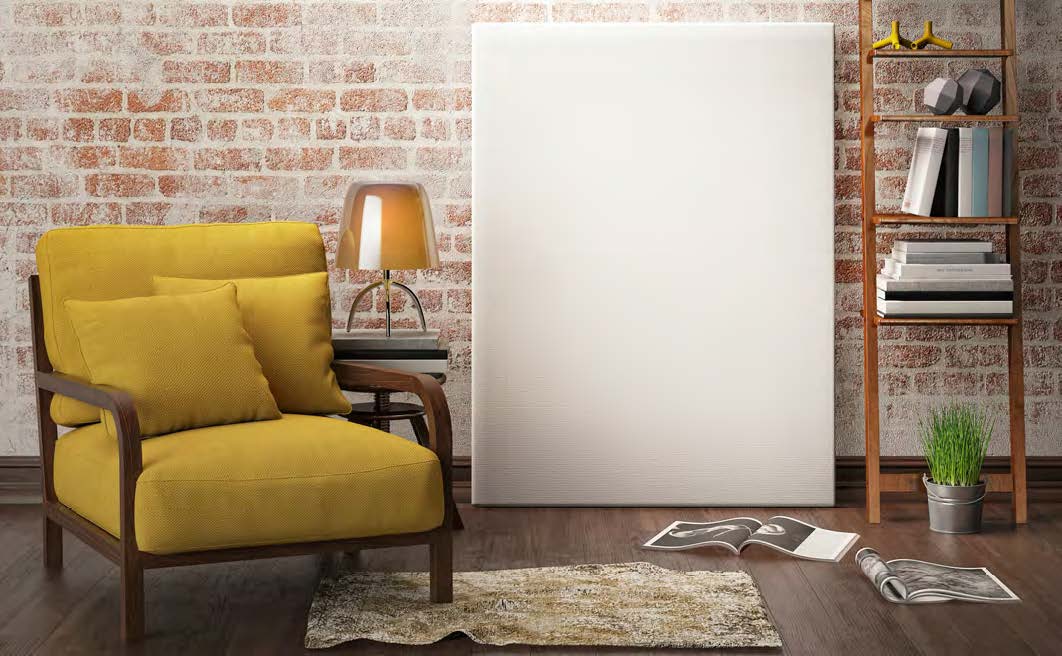
In many renovations, framed art is often at the bottom of the design budget. A designer asks that a client purchase the key elements first: flooring, furniture, rugs, window dressing, and decorative mouldings for the walls. These big-ticket items anchor the design aspects of the room and constitute the basis for all future metamorphoses of the room.
Most prevalent design strategies propose that these investment pieces be of good quality and as design-neutral as possible. The items that comprise the trendy and fashionable aspect of the design plan are usually cheaper and deliberately interchangeable for seasonal variety.
This situation puts custom framing in an awkward middle position, as it is neither cheap nor interchangeable. Properly custom-framed art is expensive and aligns more closely with furniture than with pillows, throws, and other accessories. Framed art that is cheap, interchangeable, and ready-made, on the other hand, requires frequent replacement due to its poor construction and general absence of real artistic value. Yet the framer still must often handle the tail end of dwindling resources for customers who show them paint chips and carpet swatches and expect things to match.
When you face this situation, all you can do is take a deep breath and dive in.
As with most other situations, preparation is key. After bellying up to your counter, what the customer sees first are your frame samples. I like to arrange mine according to finish and size. My customers don’t know or care what company supplied them, so arranging them by supplier would be unnecessarily confusing. By keeping all my similarly colored frame samples together, I ensure that my customers can see at a glance what kind of selection I offer.
I cannot overstate how necessary it is to have the right samples on display. You must have samples that reflect current styles and trends—not because you want to create trendy and fashionable framed art, but because you want to represent yourself as knowledgeable of current design trends and as a credible source of design advice.
People’s tastes change. Recently, there has been a noticeable movement toward a simpler design aesthetic. Empty-nesters are getting rid of all their heavy wood “investment” furniture and decorating with an eye for clean lines and simple shapes. Furniture retailers will tell you that white is the most common color choice for leather furniture. You will not sell anything to this customer if all the samples they see when they walk in your store are mahogany or barn-board blue.
Your frame supplier is the best resource for keeping your frame samples current. Your sales rep shows you carefully considered frame samples that coordinate with what your customers have seen in interior-design magazines. Keep an open mind when viewing samples from a frame supplier—don’t assume that your customer won’t like what you don’t like. When I was a sales rep and first went out to galleries showing them a new line of brightly colored lacquer frames, most framers were visibly repulsed. Those sweet little frames brought up all kinds of unpleasant memories of bad lacquers gone by. The framers brave enough to put those samples out were thoroughly surprised to find that their customers did not share their feelings. Clients were more than ready for some color and shine in their framing projects. Sales were so good that some colors ended up on backorder due to the unexpectedly rapid depletion of stock.
Pay attention to what your customers are asking for. Customers were asking me for wenge frames long before I carried anything with a wenge veneer. They were asking for white gallery frames long before I had the right matte white and tall stem shape that such frames required. They were asking for floater frames before I even knew what a floater frame was. We framers get caught up in the day-to-day operation of our businesses and our busy lives, and we can lose track of the dynamic nature of our customers’ desires. But this changing nature is the lifeblood of our business, so you must change along with it.
Properly implemented custom framing is a craft. It has all the attributes of fine furniture, and, like fine furniture, it is expensive. Education is the only approach to customers’ resistance to your price point. Be knowledgeable about your product and be willing to share that information. People pay more when they understand what they are purchasing. Fine Italian wood veneers look different from foils. Real metallic leafing looks different from a metallic spray finish. Acid-free mats won’t fade and discolor as paper mats will. I don’t offer paper mats, and I don’t use any materials in my gallery that are substandard, because I know that the product my gallery produces is my representation in the world. It is the best advertising I will ever do, and it has to show the quality and design expertise that my clients have every right to expect.
Do not hesitate to charge properly for your work. If you are proud of your work, you should be paid accordingly. There will always be someone willing to do it for less, but do not let that fact affect you. Good customer service and a superior product always win in the end. Great design is priceless.
People are obsessed with trends and all things trending in popular culture. The trends are unavoidable and, if you keep them in mind as reference points, rather than the full objective, they are useful tools.
For example, I have recently noticed the re-emergence of gold in interior-design compilations. It is the brassy, true-to-life gold that hasn’t been in the hardware palette in a long time. For as long as I can remember, silver has been the metallic finish of choice. The trend started with bright silver leaf, which slowly shifted into nickel and then into darker silvers with patinated finishes. Gold was the color of “Grandma’s framing,” and designers and their clients avoided it like the plague. The new gold is modern, sharply angular, narrow, and delicately textured. It will be a slow process, but be warned: Gold is coming back.
The espresso wood trend is sticking around due to its total domination of the furniture world. Because people have invested so much money in espresso-finished flooring, furniture, and cabinetry, I don’t expect the trend to disappear for a long time. There has been a lot more conversation about color forecasting and Pantone’s Color of the Year in the media this year than I remember from years past. I find that, for me, this forecast is of personal interest but of limited use in my framing projects. A change from Radiant Orchid to Marsala in the color schemes of mass-market production will never influence the directions I give my customers concerning frames and mats.
When customers come in for the final finishing touches on their newly renovated space, be confident and ready. With preparation and design savvy, you will have exactly the right tools to ensure that those last pieces of their design puzzle will be exactly what they need to finish the project off with style.









NO COMMENT